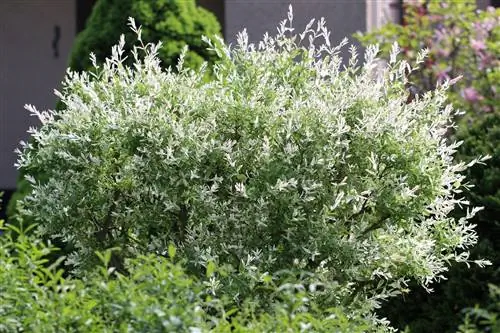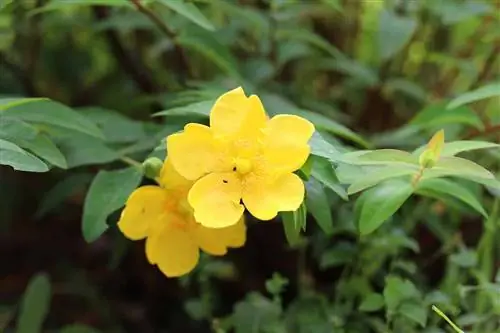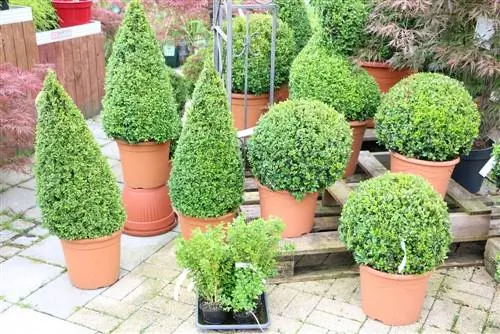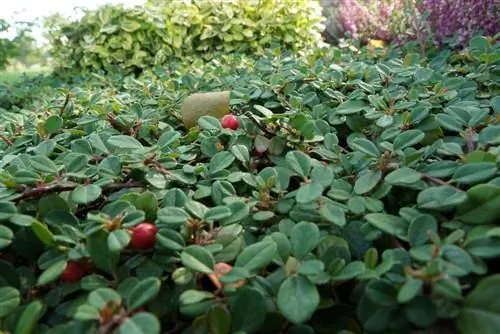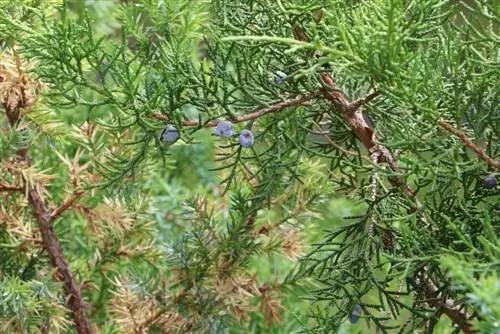- Author admin [email protected].
- Public 2023-12-17 03:39.
- Last modified 2025-06-01 06:48.
The perfect garden concept cannot do without solitary trees. In the creative interaction of short- and long-lived plants, they take on a dominant role with a significant influence on the desired style. In addition to all the aesthetic relevance, the quality of the location must not be neglected when making the decision. A wrong decision often only becomes apparent after years, and then with all its force. The selection therefore requires as much enthusiasm as care. The following overview of traditional and modern solitary trees in the garden presents summer and evergreen species.
Summer green solitary trees
The following trees shed their leaves in autumn, often after they have beautifully colored. They remain bare during the winter so that new leaves can sprout in the spring.
Garden jasmine (Philadelphus)
The elegant flowering shrub with slightly overhanging side branches presents its single or double flowers from May to July. Thanks to its vigor and undemanding nature, the garden jasmine is considered one of the most popular solitary trees ever.
- Growth height 170 to 250 cm
- Growth width 150 to 200 cm
- sunny to partially shaded location
- normal garden soil
Mother of pearl bush (Kolkwitzia amabilis)
The picturesque flowering tree impresses with pearly flowers of overwhelming abundance in May and June. The remarkable location tolerance qualifies the deciduous tree for a key role in every garden.
- Growth height 200 to 350 cm
- Growing width 150 to 300 cm
- sunny to shady location
- normal garden soil
Fan maple (Acer palmatum)
With this type of tree, the flowers take a back seat to the foliage. Depending on the cultivation, the fingered leaves present themselves in breathtaking colors, which intensify in autumn to create a breathtaking spectacle. Various varieties impress over the course of the year with marbled leaves or coral-red bark.
- Growth height up to 600 cm
- Growth width up to 200 cm
- sunny to partially shaded location
- permeable, preferably dry and sandy garden soil
Viburnum opulus
The real snowball is considered a solitary tree with an enormous long-distance effect. Especially during the flowering period from May to June, it captivates the viewer with its huge white flower balls. In autumn the light green leaves turn wine-red before they are shed.
- Growth height 250 to 350 cm
- Growing width 150 to 300 cm
- Sunny location to light partial shade
- nutrient-rich, loose garden soil
Tip:
Most solitary trees come into their own in the pot as well as in the bed. It should be noted that planted specimens are significantly more winter hardy.
Harlequin willow (Salix integra)
This trunk with a dense crown of green and white speckled foliage is a special kind of eye-catcher. Since the trunk height also defines the overall height, the solitary tree is very flexible. This makes it suitable for both large parks and small gardens.
- Growth height 100 to 200 cm
- Growing width 80 to 120 cm
- sunny locations
- loamy, permeable, humus-rich garden soil
Ornamental cherry (Prunus)
They are considered the incarnation of magical spring blossoms and are almost predestined to be a solitary tree. Ornamental cherries are available in a wide variety of varieties in many colors and sizes. In late autumn the foliage says goodbye with a fireworks display of orange-red and yellow colors.
- Growth height up to 800 cm
- Growth width up to 600 cm
- full sunny location
- calcareous, deep soil
Tip:
When planting trees, the distance to buildings should correspond to the expected growth height. Shrubs and trees with a height greater than 2 meters must be planted at a distance of at least 2 meters from the neighboring property.
Evergreen solitary trees
The following trees have their leaves all year round. This means they decorate the garden even during the cold season. The individual leaf remains on the branch for an average of 12 months and is then dropped. Since this process does not occur simultaneously, an evergreen tree is never bare.
Rhododendron (Rhododendron)
The flowering shrub leads the world's ranking among the ideal solitary trees as long as it is necessary to colonize a slightly acidic location. Anyone who meets the special care requirements of a rhododendron will be rewarded with an exuberant abundance of flowers in every conceivable color shade.
- Growth height 20 to 350 cm
- Growth width 20 to 200 cm
- sunny to partially shaded location
- acidic soil with a pH of 4.2 to 5.5
Laurel Rose (Kalmia)
A small garden is visually overwhelmed when a huge solitaire appears. This cannot happen with a laurel rose. The hardy, evergreen shrub always remains compact. In spring it turns into a botanical gem thanks to its enchanting flowers. Unfortunately, all parts of Kalmia are poisonous.
- Growth height up to 150 cm
- Growth width up to 100 cm
- sunny to partially shaded location
- slightly acidic, moist garden soil without waterlogging
Shadow bell (Pieris japonica)
Hobby gardeners sometimes look for a solitary tree for shady locations in small gardens for a long time. You will find what you are looking for with the shadow bell, because this evergreen shrub does not require much light and still blooms bright red from mid-March. The shadow bell enriches the winter garden with decorative leaf decorations.
- Growth height up to 100 cm
- Growth width up to 130 cm
- Partly shaded to shady location
- humous, acidic soil, preferably sandy and dry
Evergreen Tongue Viburnum (Viburnum rhytidophyllum)
With its curved, overhanging branches, densely covered with lanceolate leaves, this tree is a feast for the eyes. Especially when the cream-white, up to 20 cm wide umbrella panicles flourish in May and June. From August onwards, black-red fruits accompany the foliage, which is up to 18 cm long. The solitary tree then keeps this dress all winter long.
- Growth height 300 to 400 cm
- Growth width 250 to 350 cm
- sunny to partially shaded location
- nutrient-rich, fresh, moist soil
Sparkleaf (Stranvaesia davidiana)
This type of tree has all the properties that a gardener wants from his solitary tree. Wintergreen, lanceolate leaves with fantastic autumn colours, a fragrant, white bloom in June and small red berries from September.
- Growth height 200 to 300 cm
- Growth width 100 to 200 cm
- sunny to partially shaded location
- any good garden soil
Strawberry tree (Arbutus unedo)
Here the name says it all, because the fruit coating is actually reminiscent of strawberries. The ability of this hardy tree to produce red fruits together with white flowers in autumn is phenomenal. Should the strawberry tree freeze back, a bold pruning will control the damage.
- Growth height 300 to 500 cm
- Growing width 300 to 600 cm
- sheltered sunny to partially shaded location
- humous, nutrient-rich soil, fresh and moist
Sugarloaf spruce (Picea glauca)
Among the numerous coniferous trees that are suitable for solitary positions, the sugarloaf spruce particularly stands out. Growing slowly, like a huge cone, it determines the visual impact of the garden. At Christmas time it invites you to decorate festively.
- Growth height 200 to 400 cm
- Growth width 100 to 180 cm
- sunny to partially shaded location
- normal garden soil
Conclusion of the editors
When choosing solitary trees in the garden, prudence is required. Both the exposed position in appearance and the location conditions must be taken into account. If you familiarize yourself with the diverse range of summer and evergreen species, you will be spoiled for choice. There is no need to make any compromises when it comes to designing a small garden, as there are fantastically beautiful shrubs and trees available for every size and every style.
What you should know about solitary trees in brief
Solitary plants bring structure to the garden and provide variety all year round. When purchasing, you can choose between evergreen and deciduous species, with the future location playing an important role. Trees with interesting leaves are particularly attractive.
Which plants are suitable as solitary trees?
- At the beginning of spring, before the leaves appear, the almond tree (Prunus triloba) produces delicate pink flowers.
- In spring and early summer, the large, white, purple-shaded flowers of magnolias are a magnificent sight.
- The foliage of the deciduous metasequoia forms a fern-like roof.
- In autumn, fragrant clusters of decorative white berries hang between the yellow leaves of the Hupeh mountain ash (Sorbus hupehensis).
- The undemanding laburnum is breathtakingly beautiful with its bright yellow flower clusters that are up to 60 cm long.
- Conifers are a year-round eye-catcher as solitary trees.
- Ideal for small gardens is the Japanese maple, a small tree with bright golden yellow foliage.
- With their branches hanging elegantly to the ground, standard roses are also very suitable as solitary plants.
What should you consider when choosing?
- It is important for a solitary tree to make the right choice or to select the right tree for your garden.
- It is crucial to find the right location for such a tree.
- Solitary trees represent a central focal point and are therefore often placed alone on lawns or in an easily visible area.
- Before planting, the final growth of the plant should definitely be considered and planned for.
Tip:
The crown shape of a tree is also not entirely unimportant when designing a garden. A slim and tall form can also be the ideal growth habit. Plant breeders offer a variety of solitary trees. Make sure you arrange your solitary plants skillfully, because this is the only way they can be shown to their best advantage.

